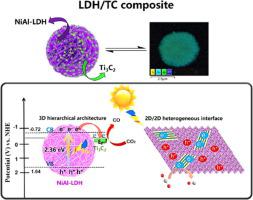Journal of Energy Chemistry ( IF 13.1 ) Pub Date : 2020-11-06 , DOI: 10.1016/j.jechem.2020.10.038 Qunrong Shi , Xiaoyue Zhang , Yong Yang , Junjie Huang , Xiaolong Fu , Tianyu Wang , Xiaodong Liu , Aiwu Sun , Jianhua Ge , Jinyou Shen , Yong Zhou , Zuliang Liu

|
Photocatalytic conversion of CO2 into a special chemical fuel with high yield and selectivity is still a major challenge. Herein, a 3D hierarchical NiAl-LDH/Ti3C2 MXene (LDH/TC) nanocomposite is constructed through in situ loading of Ti3C2 nanosheets on the NiAl-LDH scaffold during the hydrothermal process. The formation of a uniform and well-defined 2D/2D heterogeneous interface can be realized by optimizing the ratio of Ti3C2 and the precursors for NiAl-LDH. The 3D hierarchical scaffold with high specific surface area contributes to the favourable photon adsorption and utilization. The intimate contact between Ti3C2 and NiAl-LDH with numerous interfaces effectively promotes the separation of the photoinduced electron-hole pairs in NiAl-LDH. Together with the highly exposed oxidation–reduction active sites and the enhanced CO2 capture and activation. The maximum photocatalytic CO production rate on NiAl-LDH/Ti3C2 reaches 11.82 μmol g−1h−1 with 92% selectivity and superior stability. This work provides an effective approach for the development of an ideal photocatalyst by collaborative utilization of materials with different dimensionalities.
中文翻译:

NiAl-LDH / Ti 3 C 2纳米复合材料中的3D分层体系结构与2D / 2D界面相互作用共同实现了CO 2的高效和选择性光转化
将CO 2光催化转化为具有高收率和选择性的特殊化学燃料仍然是主要挑战。在本文中,通过在水热过程中将Ti 3 C 2纳米片原位负载在NiAl-LDH支架上,构建了3D分层NiAl-LDH / Ti 3 C 2 MXene(LDH / TC)纳米复合材料。可以通过优化Ti 3 C 2和NiAl-LDH的前体的比例来实现均匀且定义明确的2D / 2D异质界面。具有高比表面积的3D分层支架有助于良好的光子吸附和利用。Ti 3之间的紧密接触具有许多界面的C 2和NiAl-LDH有效地促进了NiAl-LDH中光致电子-空穴对的分离。以及高度暴露的氧化还原活性位点以及增强的CO 2捕获和活化。NiAl-LDH / Ti 3 C 2上的最大光催化CO生成速率达到11.82μmolg -1 h -1,具有92%的选择性和出色的稳定性。这项工作为通过协作利用不同尺寸的材料开发理想的光催化剂提供了有效的方法。


























 京公网安备 11010802027423号
京公网安备 11010802027423号